E. A. Basher1, 2, M. A-Z. Eltayeb1
1Department of Chemistry, Faculty of Science and Technology, Al- Neelain University, Khartoum, Sudan
2Abstracted from the Ph.D. Thesis of E.A.B
Correspondence to: E. A. Basher, Department of Chemistry, Faculty of Science and Technology, Al- Neelain University, Khartoum, Sudan.
| Email: |  |
Copyright © 2014 Scientific & Academic Publishing. All Rights Reserved.
Abstract
The H-Point Standard Addition Method (HPSAM) was applied for the simultaneous spectrophotometric determination of cobalt (II) and zinc (II). Beer’s law was obeyed at 584nm for Co(II) and 572nm for Zn(II) in the concentration range 5.0X10-6 to 5.0×10-5 mol/L, using xylenol orange (XO) as chromogenicreagent. Both Co (II) and Zn(II) form intenselyred colored complex with xylenol orange at pH 4.4. The absorbance at the selected wavelength pair, 552 and 584 nm were monitored with the addition of standard solution of cobalt(II). The results of applying H-point standard addition method show that cobalt(II) and zinc(II) ions can be determined simultaneously with concentration ratio of 20:1 and 1:20 (wt/wt). The R.S.D for a solution containing cobalt(II) and zinc(II) both at 2.0X10-6 M were 3.89% and 4.54% respectively. The effect of diverse ions on the determination of cobalt (II) and zinc (II) were also investigated. The proposed method was successfully applied to the simultaneous determination of cobalt (II) and zinc (II) in synthetically spiked mixtures and cobalt (II) in vitamin B12 samples.
Keywords:
H- point standard addition method, Cobalt (II), Zinc(II), Xylenol orange
Cite this paper: E. A. Basher, M. A-Z. Eltayeb, H-Point Standard Addition Method for Simultaneous Spectrophotometric Determination of Cobalt (II) and Zinc (II) Ions, Advances in Analytical Chemistry, Vol. 4 No. 2, 2014, pp. 21-29. doi: 10.5923/j.aac.20140402.01.
1. Introduction
Cobalt and zinc appear together in many real samples. Cobalt is an essential micronutrient for animals. It is a constituent of vitamin B12 which is necessary for normal red blood cell formation and is involved with certain enzymes. [1, 2] Cobalt is not considered to be as toxic as most of the heavy metals, although insufficient or excessive intake may lead to deficiency or toxicity that results in flushing vasodilatation and cariomyopathy in humans and animals. [3] Zinc is an essential micronutrient for plants and animals and is associated with many enzymes and with certain other proteins. It is an essential component of a number of enzymes present in animal tissues. [1, 2] Zinc compounds have biocidal activity because they precipitate and denature the bacterial proteins. For this reason it has been used in dermatology as an antiseptic and disinfectant agent in ophthalmic and mouthwash solutions and mineral – vitamin preparations. [4] Several techniques, such as ion chromatography [5], liquid -liquid extraction with atomic absorption spectrometry [6], atomicfluorescence spectrometry [7], x-rayfluorescence spectrometry [8, 9] graphite furnace atomic absorption spectrometry [10], inductively coupled plasma atomic emission spectrometry [11] and chemo-metricmethods [12] have been applied for the simultaneous determination of cobalt and zinc ions in different samples. Among the most widely used analytical methods are those based on UV-Vis spectrophotometry techniques [13], due to both experimental rapidity, simplicity and broad application.In 1988, Bosch -Reig and Campins-Falco delineated the fundamentals of H- point standard addition method (HPSAM), with which two species with mostly or even totally overlapping spectra can be determined. HPSAM is applied to work at two selected wave lengths where the analytical signal due to one of the species (interferent)is constant and for another one (analyte) to be different as mush as possible. By plotting the analytical signals versus added analytical concentration, two straight lines are obtained that have a common point H with coordinates (-CH, AH), where – CH is the unknown analyte concentration and the AH is the analytical signal due to the interferent species. [4] In this work, a selective H- point standard addition method has been developed for the simultaneous determination of cobalt(II) and zinc(II), employing xylenol orange (XO) as achromogenic complexion agent in a buffer at pH 4.4.
2. Experimental
2.1. Reagents
All chemicals used were of analytical reagent grade unless otherwise stated. Doubly distilled water was used throughout. Astock solution of 0.010MCo(II) was prepared by dissolving 0.2379g of CoCl2. 6H2O in 100 ml volumetric flask. Astock solution of 0.010M Zn(II) was prepared by dissolving 0.2875g of ZnSO4. 7HO2 in 100 ml volumetric flask. Xylenol orange stock solution of 6.6 X10-4M was prepared by dissolving 0.125g in 0.25ml concentrated hydrochloric acid and diluted in 250mlvolumetric flask [14]. The pH values of the working solution was adjusted using 0.20Macetic acid and 0.20M sodium acetate buffers. Foreign ions were prepared using their suitable salts.
2.2. Apparatus
UV-visible absorbance spectra were recorded on aShimadzuUV-1800 scanning spectrophotometer. A Tester HANNA pH- meter using a combined glass electrode is used for measurement of the pH.
2.3. General Procedure
For the determination of Co(II) and Zn(II) ions using HPSAM, the synthetic solution containing Co(II) and Zn(II) ions at different concentration ratios were prepared with 2.50ml buffer solution of pH 4.4, 2.0 ml of6.6x10-4 M (XO) were placed in a 10- ml volumetric flask. The standard addition is made versus Co(II) ion concentration, then the solutions are allowed to stand for5 min and the absorbance of solutions were measured at wavelengths 552 and 584 nm against a reagent blank .The H-point graphs are prepared by using data of absorbance and added concentration of Co(II) ion .CH and AH were obtained from the intersection point of the two derived straight lines. The concentration of Co (II) ion is evaluated from CH. The concentration of Zn(II) ion is obtained from AH value and calibration curve of analytical signal versus Zn (II) concentration.. Five replicate samples were made to check the reproducibility of the proposed method. Results were in Table (1). Co(II) and Zn(II) were determined simultaneously using the concentration ratios of Co(II) and Zn(II) varying from 20:1 to 1:20 in mixed samples.Synthetic samples containing different amounts of Co(II) and Zn(II) were prepared , and the general procedure was used for analyzing Co(II) and Zn(II) content. Vitamin B12tablets were decomposed in a 50.0 ml round bottomed flask by heating with a mixture of concentrated nitric acid (10.0ml) and sulfuric acid (1.0ml) on a hot plate until near dryness, the residue was neutralized with adilute solution of sodium hydroxide and diluted in a 25.0 ml volumetric flask with double distilled water. The cobalt content was analyzed using the general procedure. [13] 1.0 g of green tea sample was taken in a beaker, 10.0 ml of standard solution containing mixture of cobalt and zinc 2×10-3M was added. The mixture was dissolved in 5 ml concentrated nitricacid with heating. The solution was cooled, diluted and filtered. The filtrate was made up to 100 ml with deionized water in a volumetric flask. An aliquot (1ml) of the sample solution was taken into a 10ml volumetric flask containing 2.50 ml of buffer solution of pH 4.4,a known amounts of Co(II)standard solution and 2.0 ml of 6.5736711×10-4M XO was added and the solution made up to the mark with deionized water. The cobalt and zinc content were analyzed using the general procedure. 10.0 ml of standard cobalt and zinc solution 2×10-3 M was taken in a 100.0 ml flask, 20.0 ml of tap water was added and diluted to the mark by deionized water.0.5ml of the spiked tap water was placed into 10.0ml flask containing 2.50 ml of buffer solution of pH 4.4, a known amounts of Co(II) standard solution and 2.0 ml of 6.5736711×10-4M XO was added and the solution made up to the mark with deionized water. The cobalt and zinc content were analyzed using the general procedure.1.0 g of biscuits sample was taken in a beaker, 10.0 ml of standard solution containing mixture of cobalt and zinc 2×10-3 M was added. The mixture was dissolved in 5 ml concentrated nitric acid with heating. The solution was cooled, diluted and filtered. The filtrate was made up to 100 ml with deionized water in a volumetric flask. An aliquot (1ml) of the sample solution was taken into a 10ml volumetric flask containing 2.50 ml of buffer solution of pH4.4,a known amounts of Co(II) standard solution and 2.0 ml of 6.5736711×10-4M XO was added and the solution made up to the mark with deionized water. The cobalt and zinc content were analyzed using the general procedure.
3. Results and Discussion
3.1. UV –VIS Absorption Spectra
As indicated in Fig. (1) the absorption spectra of the colored Co(II)-XO and Zn(II)-XO complexes show overlapping with each other, which prevents the simultaneous determination of these ions by conventional spectrophotometry. However, the system is amenable for their simultaneous determination using the H-point standard addition method.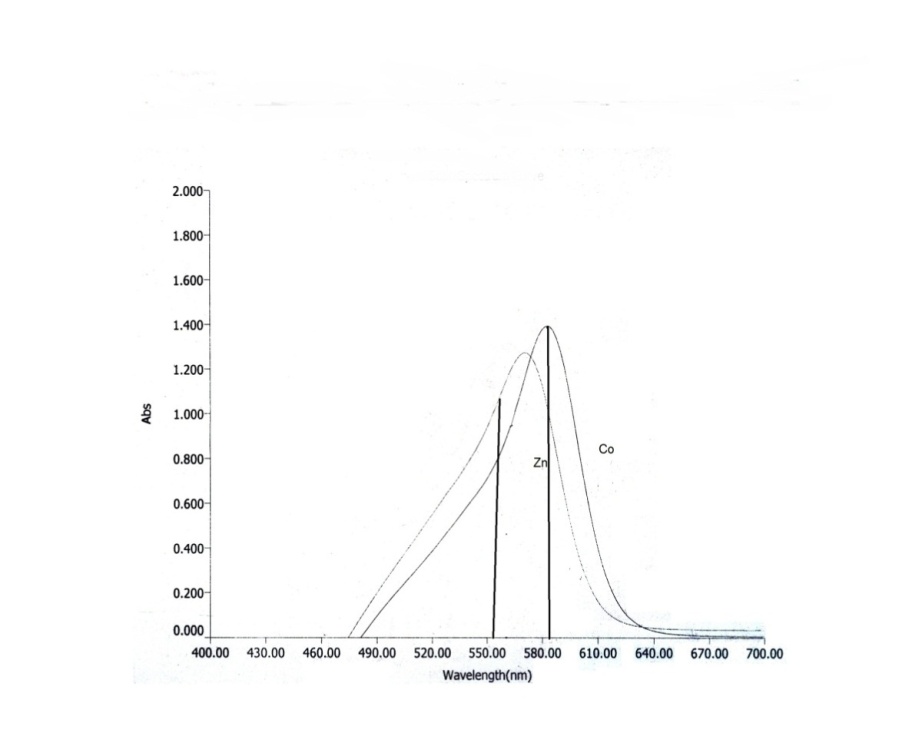 | Figure (1). Absorption spectra of Co+2-XO(C Co+2 0.001M), Zn+2-XO ( C Zn+2 0.001M), C XO 6.6×10-4 M,pH4.4 |
3.2. Determination of Optimal Conditions
3.2.1. Effect of pH on Complex Formation
The effect of the solution pH on the absorbencies of a constant concentration of Co(II) and Zn (II) complexes at λmax wavelengths of them was investigated in the range of pH 3- 5.4 using acetic acid-sodium acetate buffer. The results from Fig.(2) showed that the pH of 4.4 gives the highest sensitivity for determination of both Co(II) and Zn(II) complexes. For both cations pH 4.4 was selected as the suitable one for simultaneous analysis of Co(II) and Zn(II).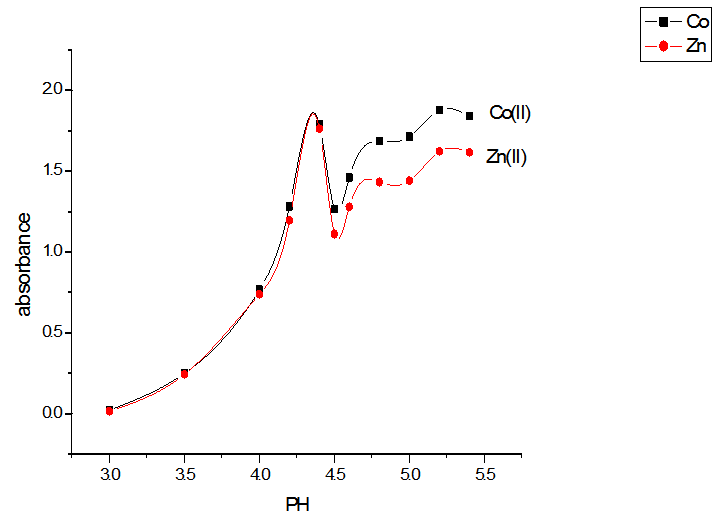 | Figure (2). Effect of pH on the absorbance of Co-XO(■) and Zn-XO(●) complexes |
3.2.2. Effect of the Amount of the Buffer pH 4.4
The effect of the volume of 0.1 buffer solution on Co(II)-XO and Zn(II)-XO absorbencies at 584 and 572 nm λmax for each respectively was studied in the range of 0.5 – 5 ml as shown in Fig.(3). The absorbencies of both Co(II) and Zn(II)complexes increase up to 2.5ml, after which the absorbance decreases. Therefore the 2.5 ml of the volume of buffer solution was selected as the optimum volume.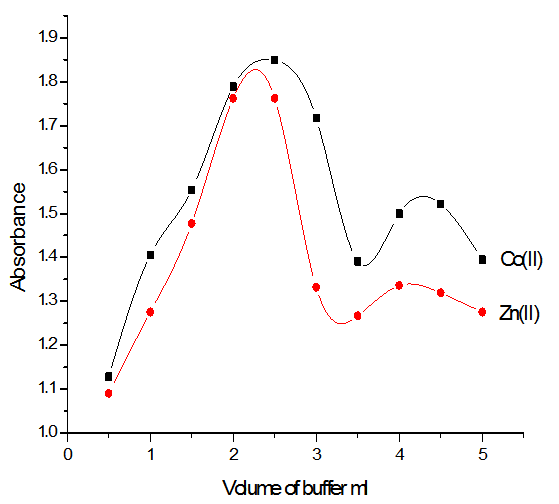 | Figure (3). Effect of volume of buffer solution pH 4.4 on the absorbance of Co-XO(■) and Zn-XO(●) complexes |
3.2.3. Effect of Xylenol Orange (XO) Concentration
The effect of different concentrations of (XO) on the absorbance of Co(II) – XO and Zn(II) – XO complexes at λmax was investigated in the range of 2x10-5M -3x10-4M of (XO). The results were given in Fig. (4). The absorbance increases with the increasing of (XO) concentration up to 1.3x10-4 M and then decreasing slightly. Thus the reagent was used at concentration of 1.3x10-4 M.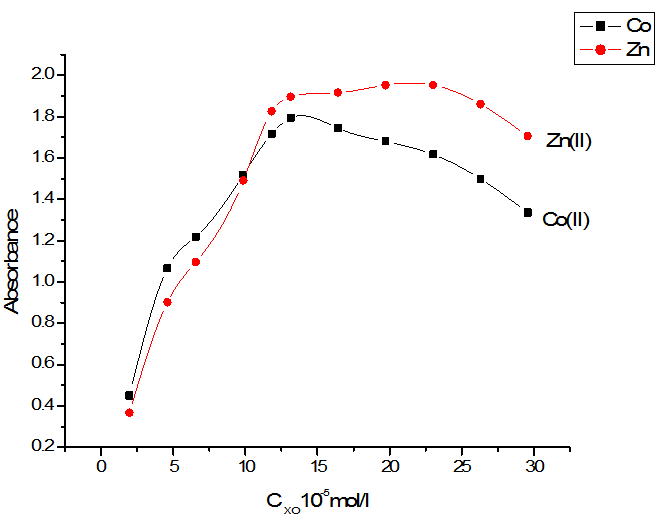 | Figure (4). Effect of xylenol orange concentration on the absorbance of Co-XO(■)and Zn-XO(●) complexes |
3.3. Stoichiometry of the Complexes
The stoichiometry of the Zn(II) complex was carried out by Job’s continues variation method. From Fig.(5), the ratio was found to be 1:2 (metal: ligand).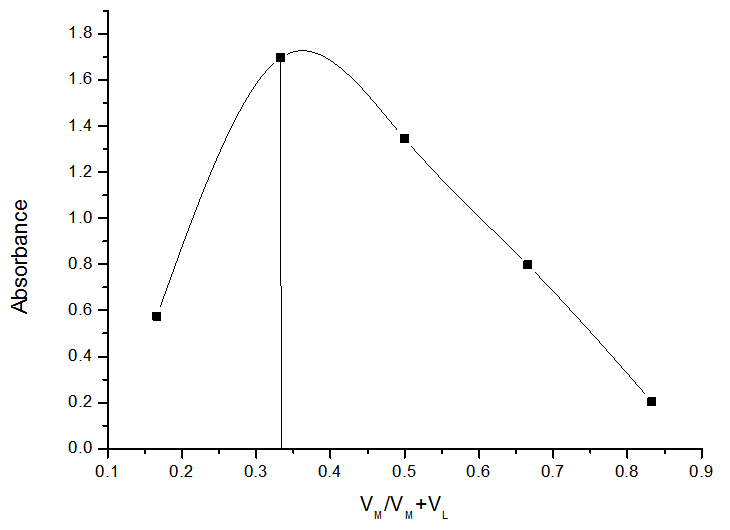 | Figure (5). Continuous variation method Zn-XO complex at 572nm, pH4.4 |
3.4. Individual Calibration Curves
Individual calibration curves for Co(II) and Zn(II) complexes were obtained automatically by plotting the absorbance against the concentration, the curve was used to individual determination of Co(II) and Zn(II) using Beer’s law were presented in Figs.(6) and (7) respectively. The molar absorptivity for Co-XO and Zn-XO complexes at their λmax were 143.5 and 145.8L mol-1 cm-1 respectively. These results were summarized in Table (1).Table (1). Statistical analysis of Co(II) and Zn(II) complexes
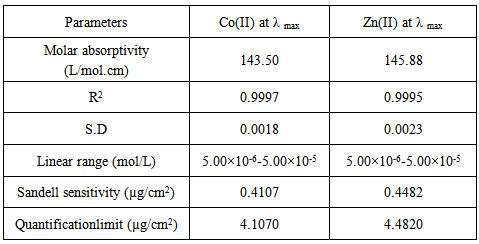 |
| |
|
3.5. Applying H-Point Standard Addition Method (HPSAM)
As seen in Fig. (1), at the selected wavelength pair for applying HPSAM is 552 and 584 nm. The analyte signal of Co(II) ions are linear with concentration, whereas, the interferent signal of Zn (II) remains constant with the increase in analyte concentration at selected wavelengths. To insure good accuracy, the Co(II) ion is considered as analyte and Zn(II) is the interferent, because the spectrum of Co-XO complex showed a large difference in absorbances at those wavelengths .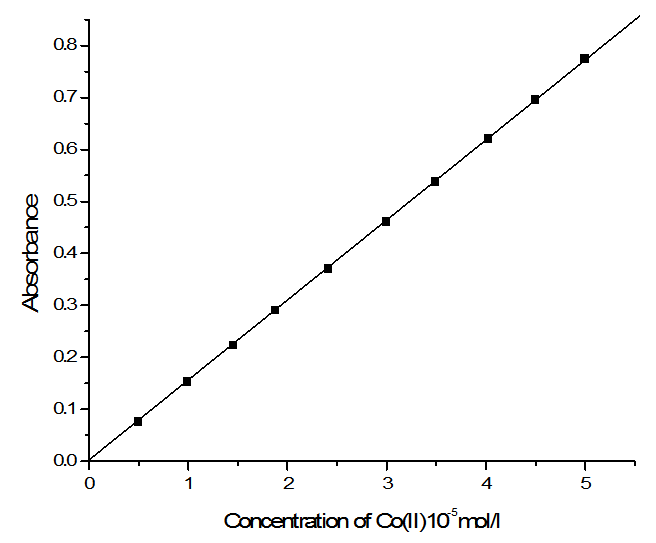 | Figure (6). Calibration curve of Co-XO complex at 584nm |
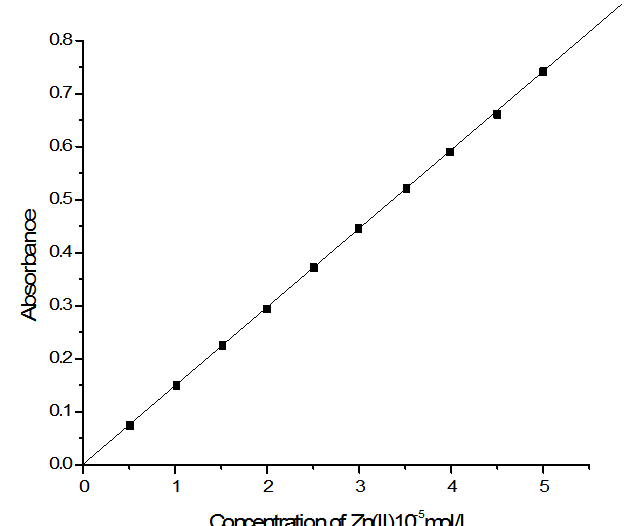 | Figure (7). Calibration curve of Zn-XO complex at 572nm |
3.6. Reproducibility of HPSAM
Simultaneous determination of cobalt and zinc under optimum conditions were performed. To check the reproducibility of the proposed method, five replicate experiments of binary samples of Co(II) and Zn(II) were done, and Table (2) presents the results. The relative standard deviations (R.S.D) for Co(II) and Zn(II) were 3.89 and 4.54% for 2.0 x10-6 M for each respectively.| Table (2). Results for five replicates for simultaneous determination of Cobalt and Zinc by HPSAM |
| | Present mol/L | Found mol/L | | Co(II) | Zn(II) | Co(II) | Zn(II) | | 0.20 ×10-5 | 0.20 ×10-5 | 0.205×10-5 | 0.201 ×10-5 | | 0.20×10-5 | 0.20×10-5 | 0.188×10-5 | 0.186 ×10-5 | | 0.20×10-5 | 0.20×10-5 | 0.191×10-5 | 0.208 ×10-5 | | 0.20×10-5 | 0.20×10-5 | 0.195×10-5 | 0.189×10-5 | | 0.20×10-5 | 0.20×10-5 | 0.186×10-5 | 0.196×10-5 | | Mean N* = 5 | 0.193×10-5 | 0.196×10-5 | | Standard deviation | 0.075×10-6 | 0.089×10-6 | | R .S. D % | 3.89% | 4.54% |
|
|
3.7. Applicability of the HPSAM Method
Several experiments for evaluating HPSAM on the simultaneous determination of cobalt and zinc in a series of samples containing a fixed amount of cobalt in the presence of various amounts of zinc Fig.(8) or a fixed amount of zinc in the presence of various amounts of cobalt Fig. (9) were executed. The results indicate that the cobalt and zinc contents in the samples were determined accurately. Therefore, the applicability of the proposed method to determine cobalt and zinc has been clarified. 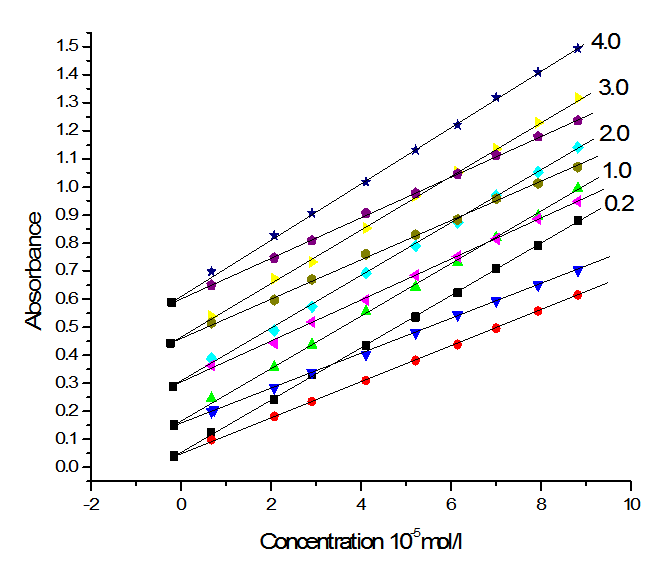 | Figure (8). H-point standard addition plot for simultaneous determination of cobalt and zinc under optimized conditions with a constant concentration of cobalt (2.0 ×10-6 M)and zinc concentration of: 0.20× 10-5 M, 1.0× 10-5 M, 2.0 ×10-5 M, 3.0 ×10-5 M and 4.0× 10-5 M |
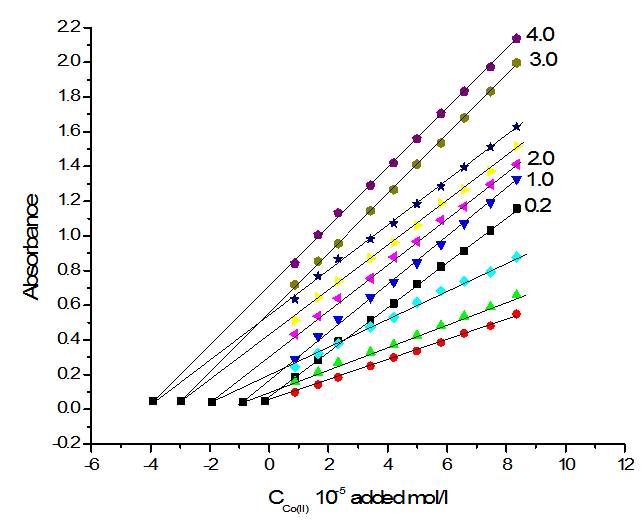 | Figure (9). H-point standard addition plot for simultaneous determination of cobalt and zinc under optimized conditions with a constant concentration of zinc (2.0 ×10-6 M)and cobalt concentration of: 0.20× 10-5 M, 1.0× 10-5 M, 2.0 ×10-5 M,3.0 ×10-5 M and 4.0× 10-5 M |
3.8. Analysis of Cobalt- Zinc Binary Mixtures
In order to obtain accuracy of the method several synthetic mixtures with different concentration ratios of Co(II) and Zn (II) were analyzed using the proposed HPSAM for the simultaneous determination of both ions. The results are given in Table (3).Table (3). Simultaneous determination of Cobalt and Zinc ions in binary mixtures by HPSAM (single determination)
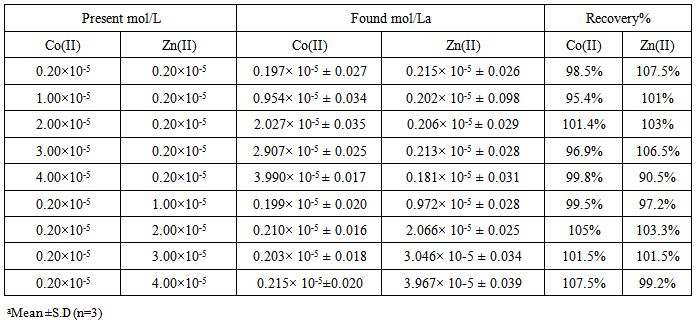 |
| |
|
3.9. Effect of Foreign Ions
The effect of various diverse ions on the absorbance of a solution containing 2.0x10-4M each of Co (II) and Zn(II) in mixture were studied. The tolerance limit was defined as the concentration of the added ion causing less than a±2% relative error. The results for both ions Table (4) indicate that most of the cations and anions showed no significant interference at weight ratios greater than 1000 Table (5) shows Al(III), Pb(II) and Ni(II) have positive effect on the signal, therefore the presence of these cations must be removed in order to obtain accurate and precise results.| Table (4). Effect of foreign anions and cationson the determination of Co(II) and Zn(II) complexes |
| | Foreign ions | Tolerance limit: Weight ratio | | K+, Ca2+, NO3-, Cl- | 1000 | | Na+, Mg2+ , SO42-, S2O32-, NO2- | 100 | | Cd2+, CrO42- | 10 | | Fe3+, Cu2+ | 1 |
|
|
| Table (5). Effect of foreign cations on the determination of Co(II) and Zn(II) complexes |
| | Sample | A584nm | A552nm | | Co(II)+Zn(II) mixture (2 10-4M) | 0.348 | 0.340 | | Mixture+ Ni (II) (2 10-4M) | 0.498 | 0.492 | | Mixture+ Pb (II) (2 10-4M) | 0.570 | 0.565 | | Mixture +Al (III) (2 10-4M) | 0.626 | 0.391 |
|
|
4. Application of the HPSAM
The proposed method was successfully applied to the determination of cobalt and zinc in spiked tap water, biscuits, and green tea samples. Also HPSAM was applied for analyzing cobalt in vitamin B12 tablets. The results of analysis were shown in Table (6). The good agreement between these results and known values indicate the successful applicability of the proposed method for simultaneous determination of Co(II) and Zn(II) in real samples.Table (6). Determination of cobalt and zinc in different samples by HPSAM
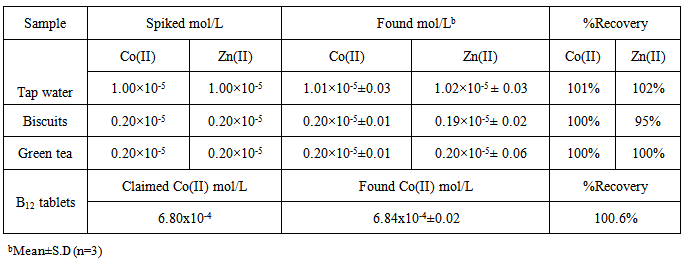 |
| |
|
5. Conclusions
The H-point standard addition method has been used in simultaneous determination of cobalt(II) and zinc(II) ions at trace levels using xylenol orange as chromogenic reagent at pH 4.4. The proposed method provides satisfactory results in synthetic mixtures and several real matrix samples. The developed method is simples, low cost of the instrument, easy handling, rapid and precise.
References
| [1] | Allen S.E., Chemical Analsis of Ecological Materials, 2nd Ed., Black well scientific publication, Great Britain, 1989, 86. |
| [2] | Harper H.A. Rodwell V.W. and Mayes P.A., Review of physiological chemistry, 17thEd., Lagat Medical publication, Canada, 1979, 575. |
| [3] | Nai-Laing Hu, Hong-Wen Gao, Biao Zhang and Guo-Qing Zhan, J. Chim. Chem. Soc.,52, 2005, 1145. |
| [4] | Rajni R. and Usha G., Chem. Sci. Trans., 1(3), 2012, 582. |
| [5] | Caprioli R. and Torcini S., J. Chromatogr. A., 640, 1993, 365. |
| [6] | Garcia-Vargas M., Hernandez-Artiga M. P. and Perez-Bustamante J. A., Anal. Chim. Acta., 157, 1984, 363. |
| [7] | Jones M., Kirkbright G. F., Ranson L. and West T. S., Anal. Chim. Acta, 63, 1973, 210. |
| [8] | Morris A. W., Anal.Chim. Acta, 42, 1968, 397. |
| [9] | Jing Z. T., Yu J. C. and Liu H. Y., Anal. Sci., 21, 2005, 851. |
| [10] | Belarra M. A.,Crespo C., Martinez-Garbayo M. P. and Resano M., Spectrochim. Acta B, 58, 2003, 1847. |
| [11] | Rao K. S., Balaji, T., Rao T. P., Babo Y. and Naidu G. R. K., Spectrochim. Acta B, 576, 2002, 1333. |
| [12] | Ghasemi J., Ahmed S. and Torkestani K., Anal. Chim. Acta,487, 2003, 181. |
| [13] | Pouretedal H. R. and Sefi M., J. Iran. Chem. Soc.,4, 2007, 503. |
| [14] | Abdul M., Dur E. S., Asma R. N. and Sanaulla M., Jour. Chem. Soc. Pak., 18, 1996, 197. |










 Abstract
Abstract Reference
Reference Full-Text PDF
Full-Text PDF Full-text HTML
Full-text HTML

